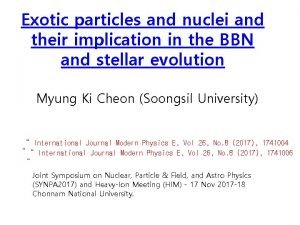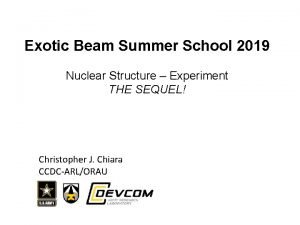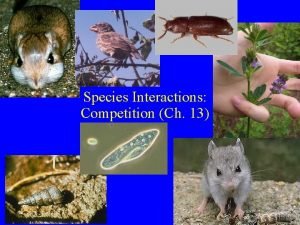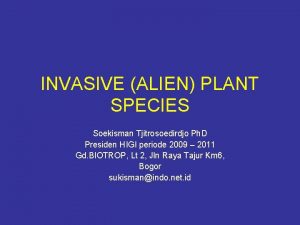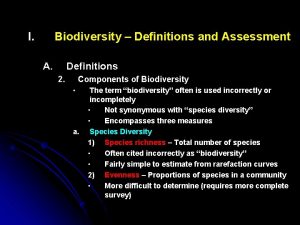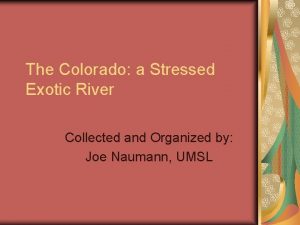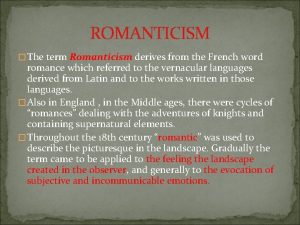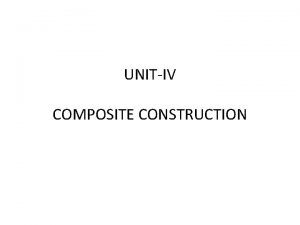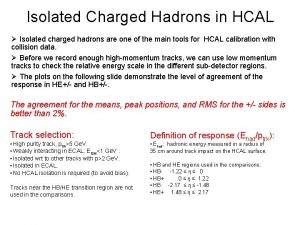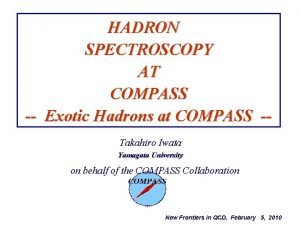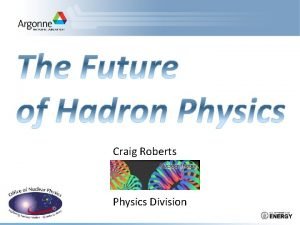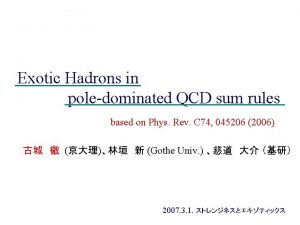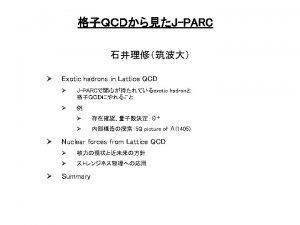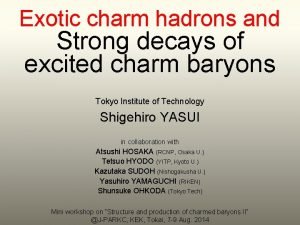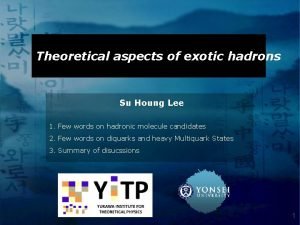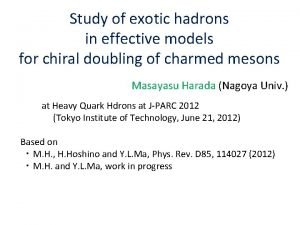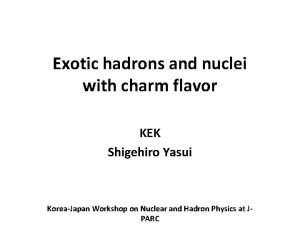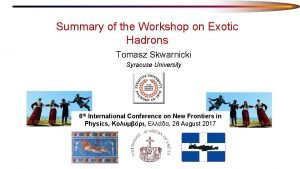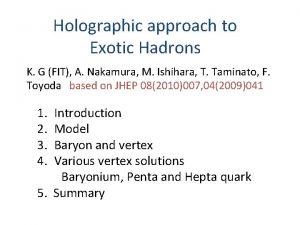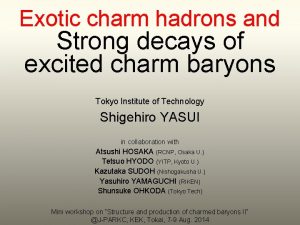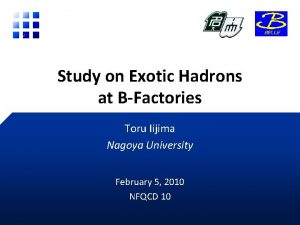A composite model for exotic hadrons YongLiang Ma




























![X(3872) First observed by the Belle Collaboration: S. K. Choi et al. [Belle Collaboration], X(3872) First observed by the Belle Collaboration: S. K. Choi et al. [Belle Collaboration],](https://slidetodoc.com/presentation_image_h2/05dfd161806dd9054b8cbbca3fb93062/image-29.jpg)


![JPC = 2 -+ 2012/7/12 [7] K. Abe et al. (Belle Collaboration), hep-ex/0505037. [8] JPC = 2 -+ 2012/7/12 [7] K. Abe et al. (Belle Collaboration), hep-ex/0505037. [8]](https://slidetodoc.com/presentation_image_h2/05dfd161806dd9054b8cbbca3fb93062/image-32.jpg)




- Slides: 36

A composite model for exotic hadrons Yong-Liang Ma Department of Physics, Nagoya University. Talk given @ Crossover Workshop, Jul. 12 – Jul. 13, 2012, Nagoya

Outline I. Introduction II. Field theory foundations of a composite model III. Molecular structures of Ds 0*(2317) and Ds 1(2460) IV. Hidden charm molecular states V. Final remarks 2012/7/12 Composite model @ Crossover 2012 2

I. Introduction Ø Charm physics has played important roles in particle physics and the spectroscopy of charmed mesons has been well predicted in the constituent quark models. Ø But this situation changed since 2003 due to the observation of some ``exotic" states. Ø These states have properties do not consistent with the constituent quark model predictions for mesons made of a quark and an antiquark. Ø Revealing the structures of these states and understanding their decay and production properties are interesting and important problems. Ø In the literature, some of these exotic states have been interpreted as molecules, i. e. , deuteron-like bound states of colorless objects. Ø The purpose of this talk: Explain a molecular model based on the compositeness condition. 2012/7/12 Composite model @ Crossover 2012 3

New charm-strange states. 2012/7/12 A. Valcarce @ Charm 2010 Composite model @ Crossover 2012 4

Hidden charm spectroscopy 2012/7/12 M. Nielsen @ Charm 2010 Composite model @ Crossover 2012 5

Some of them have properties do not fit into quark model calculations Exotic states Possible interpretation: Hadronic Molecule 2012/7/12 Composite model @ Crossover 2012 6

Molecular and tetraquark interpretations differ by the way quarks are organized in the state 2012/7/12 Composite model @ Crossover 2012 7

Field theory foundation of a composite model Ø In quantum field theory we regard a particle as a composite one provided that it is not included in the original Lagrangian. Ø Salam's criterion: The wave function renormalization constant Z 3 for boson (or Z 2 for Fermion) should be equal to zero for a composite particle. A. Salam, Nuovo Cim. 25: 224 -227, 1962; Phys. Rev. 130: 1287, 1963. Ø In the limit of the vanishing of the wave function renormalization constant associated with φ, predictions of theory coincide with those of a theory in whose Lagrangian φ does not appear explicitly and in which the particles associated with φ emerge as bound state. 2012/7/12 Composite model @ Crossover 2012 8

Consider Yukawa interaction and four-Fermion interaction: D. Lurié and A. Macfarlane, Phys. Rev. 136 : B 816, 1964. G 0 : bare coupling constant g 0 : bare coupling constant Yukawa Four-Fermion 2012/7/12 Composite model @ Crossover 2012 9

Yukawa interaction: Fermion-fermion scattering amplitude Dressed Boson propagator Momentum transferred to the Boson propagator Bare mass Physical Fermion mass 2012/7/12 Composite model @ Crossover 2012 10

The residual of the μ 2 pole gives the φ field wave function renormalization constant 2012/7/12 Composite model @ Crossover 2012 11

Define the physical coupling constant: Four Fermion interaction: 2012/7/12 Composite model @ Crossover 2012 12

The condition for: 2012/7/12 Composite model @ Crossover 2012 13

Ø This condition can be proved to all orders of perturbation theory. Ø The method of the derivation is the comparison of the integral equations for the basic Green's functions in the two theories. Ø The boson as a bound state can not arise as external line. Since each external line contributes a factor 2012/7/12 Composite model @ Crossover 2012 14

Ø Write down the effective Lagrangian for the exotic state and its ocnstituents. g Ø Determine the couping constant g using the compositeness conditoin = g^2 Π(q^2) = 1 Ø Calculate the decay and production processes using the determined coupling constant g 2012/7/12 Composite model @ Crossover 2012 15

III. Molecular structures of Ds 0*(2317) and Ds 1(2460) 2012/7/12 Composite model @ Crossover 2012 16

Ø Their spectrum do not fit into potential model and other theoretical approach. 2012/7/12 Composite model @ Crossover 2012 17

Ø Quark model calculation and heavy quark symmetry: j=3/2 j=1/2 Ds 1(2536), Ds. J(2573). Narrow, agree with experiments. missing! Broad, decay into DK and D*K. Ø Observation: Narrow! Isospin-violating decay channel! It’s difficult o identify Ds 0*(2317) and Ds 1(2460) as P-wave quarkantiqiuark states. They are maybe exotic states: The proximity of the DK (D*K) threshold to Ds 0*(2317)(Ds 1(2460)) masses favor a molecular state 2012/7/12 Composite model @ Crossover 2012 18

The Molecular structures of Ds 0*(2317) and Ds 1(2460) A. Faessler, et al. , Phys. Rev. D 76, 014005 (2007), 76, 114008 (2007). Effective Lagrangian 2012/7/12 Composite model @ Crossover 2012 19

Compositeness condition: 2012/7/12 Composite model @ Crossover 2012 20

Strong decay Ds 0* 2012/7/12 D s π0 Composite model @ Crossover 2012 21

Strong decay Ds 1 2012/7/12 Ds * π 0 Composite model @ Crossover 2012 22

Ds 0*→Ds*γ 2012/7/12 Ds 1 →Dsγ Composite model @ Crossover 2012 23

Numerical results for Ds 0* → Dsπ0 at Λ=1. 0 – 2. 0 Ge. V 2012/7/12 Composite model @ Crossover 2012 24

Numerical results for Ds 1 → Ds*π0 at Λ=1. 0 – 2. 0 Ge. V 2012/7/12 Composite model @ Crossover 2012 25

2012/7/12 Composite model @ Crossover 2012 26

2012/7/12 Composite model @ Crossover 2012 27

IV. Hidden charm molecular states ü There is J/ψ or ψ(2 S) in their decay products ➔ they have a pair c c as their quark components ü Their masses do not fit into the quark model predictions for charmonium states. ü Absence of open charm production in their decays ➔ inconsistent with charmonium interpretation. ü Candidates for exotic (not quark-antiquark) states. Some of them have been interpreted as molecular states. 2012/7/12 Composite model @ Crossover 2012 28
![X3872 First observed by the Belle Collaboration S K Choi et al Belle Collaboration X(3872) First observed by the Belle Collaboration: S. K. Choi et al. [Belle Collaboration],](https://slidetodoc.com/presentation_image_h2/05dfd161806dd9054b8cbbca3fb93062/image-29.jpg)
X(3872) First observed by the Belle Collaboration: S. K. Choi et al. [Belle Collaboration], Phys. Rev. Lett. 91, 262001 (2003). Confirmed by CDF, D 0 and Ba. Bar. Quantum numbers of X(3872): JP =1++ , 2 - + 2012/7/12 Composite model @ Crossover 2012 29

Because of the mass and presence of c c pair in the decay products one might expect the charmonium nature of X(3872). Measurement of the invariant mass distribution of π+ πindicates that the decay X → J/ψπ+ π- occurs via intermediate process X → J/ψρ0 decay. Since charmonium decay to J/ψρ0 violates isospin symmetry, this observation is a strong argument against charmonium nature of X(3872) state. A Possible Molecular state 2012/7/12 Composite model @ Crossover 2012 30

M. Harada and Y. M. PTP 126 (2011)91. In isospin eigenstate 2012/7/12 Composite model @ Crossover 2012 31
![JPC 2 2012712 7 K Abe et al Belle Collaboration hepex0505037 8 JPC = 2 -+ 2012/7/12 [7] K. Abe et al. (Belle Collaboration), hep-ex/0505037. [8]](https://slidetodoc.com/presentation_image_h2/05dfd161806dd9054b8cbbca3fb93062/image-32.jpg)
JPC = 2 -+ 2012/7/12 [7] K. Abe et al. (Belle Collaboration), hep-ex/0505037. [8] B. Aubert et al. (BABAR Collaboration), Phys. Rev. Lett. 102 (2009), 132001. Composite model @ Crossover 2012 32

Our result of the small mixing angle implies that the isospin singlet component is dominant. Wave function: 2012/7/12 Composite model @ Crossover 2012 33

Other exotic hadrons studied using this model Ø |X(4350) 〉 = |Ds 0*+ Ds*- 〉+ |Ds 0*- Ds*+ 〉 Ø |Y(3940) 〉 = |D*+ D*- 〉+ |D 0*0 D*0 〉 Ø |X(4350) 〉 = |Ds*+ Ds*- 〉+ |Ds 0*- Ds*+ 〉 Ø Ø Ø 2012/7/12 Composite model @ Crossover 2012 34

V. Conclusion The composite model was applied in the study of some exotic hadrons by regarding them as hadronic molecular states. Advantages: The model is clear and straightforward. Disadvantages: The mediate force is hidden, Although the model is crude, we hope it can give some insight into the structures of some exotic resonances. . To confirm the structure of these exotic mesons, further theoretical an experimental studies are necessary. Thank you ! 2012/7/12 Composite model @ Crossover 2012 35

2012/7/12 Composite model @ Crossover 2012 36
 Lhc tantalizing new physics
Lhc tantalizing new physics Douglas fir modulus of elasticity
Douglas fir modulus of elasticity Exotic species definition
Exotic species definition Nuclear pasta
Nuclear pasta Two exotic breeds of rabbits
Two exotic breeds of rabbits Exotic beam summer school
Exotic beam summer school Exotic species definition
Exotic species definition Woman walking in an exotic forest
Woman walking in an exotic forest Advantages and disadvantages of shannon diversity index
Advantages and disadvantages of shannon diversity index Exotic species definition
Exotic species definition Exotic species definition
Exotic species definition Exotic species definition
Exotic species definition Is the colorado river an exotic stream
Is the colorado river an exotic stream Houston luxury rental cars
Houston luxury rental cars Romsnticism
Romsnticism Static hedging of exotic options
Static hedging of exotic options Kontinuitetshantering
Kontinuitetshantering Typiska novell drag
Typiska novell drag Nationell inriktning för artificiell intelligens
Nationell inriktning för artificiell intelligens Ekologiskt fotavtryck
Ekologiskt fotavtryck Varför kallas perioden 1918-1939 för mellankrigstiden?
Varför kallas perioden 1918-1939 för mellankrigstiden? En lathund för arbete med kontinuitetshantering
En lathund för arbete med kontinuitetshantering Personalliggare bygg undantag
Personalliggare bygg undantag Tidbok yrkesförare
Tidbok yrkesförare Anatomi organ reproduksi
Anatomi organ reproduksi Vad är densitet
Vad är densitet Datorkunskap för nybörjare
Datorkunskap för nybörjare Stig kerman
Stig kerman Att skriva en debattartikel
Att skriva en debattartikel Magnetsjukhus
Magnetsjukhus Nyckelkompetenser för livslångt lärande
Nyckelkompetenser för livslångt lärande Påbyggnader för flakfordon
Påbyggnader för flakfordon Arkimedes princip formel
Arkimedes princip formel Offentlig förvaltning
Offentlig förvaltning I gullregnens månad
I gullregnens månad Presentera för publik crossboss
Presentera för publik crossboss Teckenspråk minoritetsspråk argument
Teckenspråk minoritetsspråk argument



